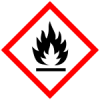Toxicty
GHS safety labels
About Globally Harmonized System of Classification and Labelling of Chemicals (GHS)
From Wikipedia: The Globally Harmonized System of Classification and Labelling of Chemicals (GHS) is an internationally agreed-upon standard managed by the United Nations that was set up to replace the assortment of hazardous material classification and labelling schemes previously used around the world. Core elements of the GHS include standardized hazard testing criteria, universal warning pictograms, and harmonized safety data sheets which provide users of dangerous goods with a host of information. The system acts as a complement to the UN Numbered system of regulated hazardous material transport. Implementation is managed through the UN Secretariat. Although adoption has taken time, as of 2017, the system has been enacted to significant extents in most major countries of the world.[1] This includes the European Union, which has implemented the United Nations' GHS into EU law as the CLP Regulation, and United States Occupational Safety and Health Administration standards.
- H226

Flammable liquid and vapour
Class: Flammable
Subclass: Liquids - H302

Harmful if swallowed
Class: Acute Toxicity
Subclass: Oral - H304
May be fatal if swallowed and enters airways
Class: Aspiration Hazard - H312

Harmful in contact with skin
Class: Acute Toxicity
Subclass: Dermal - H315

Causes skin irritation
Class: Corrosion/irritation
Subclass: Skin - H317

May cause an allergic skin reaction
Class: Sensitization
Subclass: Skin - H319

Causes serious eye irritation
Class: (Corrosion)Damage/irritation
Subclass: Eye - H332

Harmful if inhaled
Class: Acute Toxicity
Subclass: Inhalation - H411

Toxic to aquatic life with long lasting effects
Class: Aquatic
Subclass: Chronic
